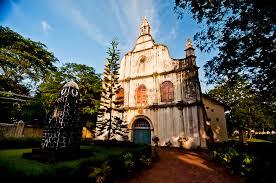Fort Kochi, located in the coastal city of Kochi in Kerala, is a place where history, culture, and tradition blend seamlessly to create a unique atmosphere. Known for its colonial charm, Fort Kochi has witnessed centuries of changing rulers, diverse cultures, and global trade. From the Portuguese to the Dutch, the British to the local Kochi kings, the area has been home to various influences, all of which have left their indelible marks on the city’s heritage.
In this article, we explore the rich history of Fort Kochi and uncover some of its untold stories, offering a deeper look at what makes this historical place so special.
Fort Kochi: The Early Beginnings
The Fort Kochi history dates to the ancient trading routes that passed through the Arabian Sea. Long before the arrival of European colonizers, Kochi was an important port for Arab traders, who brought goods like spices, silk, and precious stones to this vibrant coastal city. The city’s position on the Malabar Coast made it a major hub for international trade.
Kochi has been an important place for the foreign traders since centuries, and it was not long before the European powers started to arrive in the region.
The Portuguese Period (1500-1663)
It was the year 1500 when the Portuguese, under the great explorer Vasco da Gama, came to Kochi. The beginning of European influence in the area started from this time. They established a strong hold in Fort Kochi and began constructing fortifications to safeguard their trading interests. In 1503, they built the first Portuguese fort in Kochi and gave the name Fort Kochi.
During this time, the Portuguese missionaries also built churches, and their presence is still visible today in the form of St. Francis Church, one of the oldest European churches in India. It is in this church that Vasco da Gama was originally buried before his remains were later taken to Portugal.
The Portuguese influence in Fort Kochi lasted for over 150 years, and they were key in establishing the spice trade routes that made Kochi a rich and prosperous region. However, their dominance was soon challenged by the Dutch.
The Dutch Era (1663-1795)
In 1663, the Dutch East India Company defeated the Portuguese in a battle for the possession of Fort Kochi and surrounding areas. During its more than 130-year reign, the Dutch made drastic alterations to the region. Among its significant contributions are a few buildings and fortifications that have remained standing to this day.
The Dutch Palace (Mattancherry Palace) was renovated during Dutch rule. This region was then a center from where the Dutch could oversee the trade in the Malabar Coast. The Dutch also traded in spices and transformed Kochi into one of the world’s most important ports for spices, especially pepper.
The Dutch influence is visible in Fort Kochi’s architecture, with several buildings still exhibiting Dutch colonial elements like arched windows, gabled roofs, and decorative woodwork.
The British Era (1795-1947)
In 1795, the British East India Company took control of Fort Kochi after defeating the Dutch in the Anglo-Dutch War. The British rule saw the area become part of the Princely State of Travancore, although it continued to be an important center for trade and commerce.
During British rule, Fort Kochi became a bustling port, with ships arriving from Europe, Africa, and the Far East. The British made changes to the infrastructure, adding some of their own colonial architectural elements, such as the Santa Cruz Basilica, which was constructed in the 19th century.
Though the British ruled over the region for over a century, Fort Kochi’s strategic importance gradually diminished with the rise of new trade routes and modern ports. Nonetheless, the British influence can still be seen in the area’s colonial buildings, street names, and local customs.
The Untold Stories of Fort Kochi
Fort Kochi may speak highly of its colonial past, but behind all this, there are numerous untold stories of the location, adding to the richness of its past. A few lesser-known facts of the area are as below:
1. The Jewish Community of Kochi
One of the most fascinating untold stories of Fort Kochi is the history of the Cochin Jews. The Jewish community in Kochi has existed for over a thousand years, and Jew Town in Mattancherry was once a thriving hub for Jewish traders. The Paradesi Synagogue, built in 1568, is one of the oldest active synagogues in the world and still stands today as a symbol of this community’s rich history.
The Jewish community of Kochi, known for their expertise in trade and craftsmanship, played a crucial role in the region’s economic prosperity. Over the years, however, many Jews migrated to Israel and other parts of the world, and today, only a few Jewish families remain in the area. Still, the legacy of the Jewish community continues to live on through the synagogue and the surrounding historical sites.
2. The Influence of Arab Traders
While European colonial powers are often associated with Fort Kochi, it’s important not to forget the long-standing influence of Arab traders. For centuries, Arab merchants played a major role in the spice trade, and their presence in Kochi was instrumental in shaping the region’s cultural and economic landscape. The Arab influence is evident in local cuisine, language, and architecture.
Kochi has a long tradition of Arab merchants settling in the region, and they were some of the first to bring Islam to the area. Even today, the Cherai Beach area near Fort Kochi is home to some of the oldest mosques in the region, built by Arab traders.
3. The Chinese Fishing Nets
The Chinese fishing nets in Fort Kochi are another fascinating feature of the area, but their origin remains an untold mystery. These large, mechanical fishing nets are believed to have been brought to the region by Chinese traders in the 14th century, although the exact origin and timeline of their introduction remain unclear. The fishing nets are still in use today, adding a unique charm to Fort Kochi’s waterfront.
Visitors can often see these nets being operated by local fishermen, offering a glimpse into the traditional fishing methods that have been practiced for centuries.
4. The Battle of Kochi
Another untold story is the Battle of Kochi, which took place in the 16th century when the Portuguese and the Dutch fought for control of the region. This battle marked a significant turning point in the history of Fort Kochi, as the Dutch defeated the Portuguese and took over the region. The battle is often overlooked in the broader narrative of colonialism in India, but it played a critical role in shaping the city’s future.
Fort Kochi Today
Today, Fort Kochi is a popular tourist destination that combines its colonial past with a modern, cosmopolitan atmosphere. The area is known for its art galleries, cafes, boutiques, and vibrant cultural scene, particularly during the Kochi-Muziris Biennale, an international contemporary art exhibition held every two years. Despite the growth of tourism, Fort Kochi has managed to maintain its unique blend of old and new, making it a living museum of sorts.
Visitors can still walk through the streets of Fort Kochi and see the colonial buildings, ancient churches, and historic landmarks that tell the story of its complex past. The untold stories of the region — from the Jewish community to the influence of Arab traders — add depth to the historical narrative and provide visitors with a more complete understanding of the area’s rich heritage.
Conclusion
The history of Fort Kochi is a fascinating tapestry of different cultures, civilizations, and stories. From its early days as a bustling port for Arab traders to its time under Portuguese, Dutch, and British rule, Fort Kochi has seen many changes over the centuries. Its untold stories, such as the history of the Jewish community, the influence of Arab merchants, and the legacy of the Chinese fishing nets, offer a deeper and richer understanding of this beautiful coastal town.

